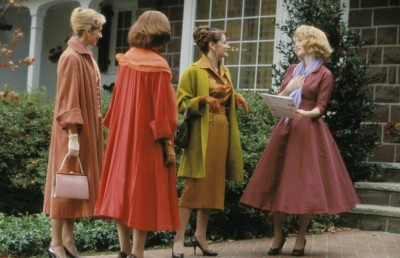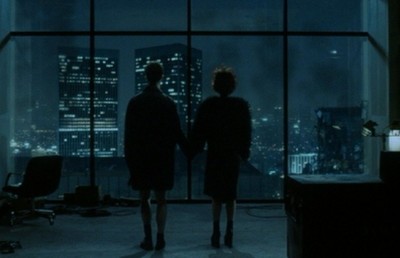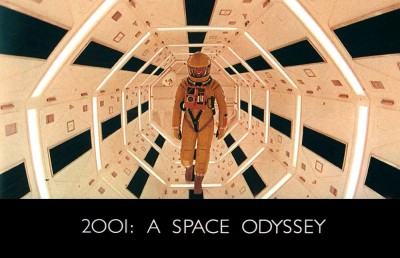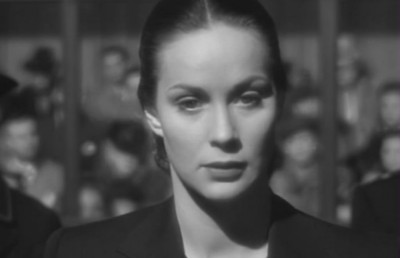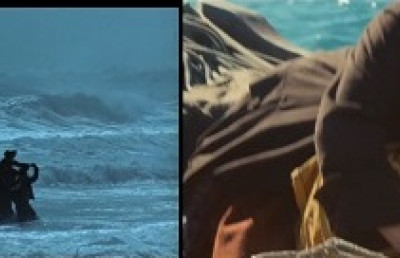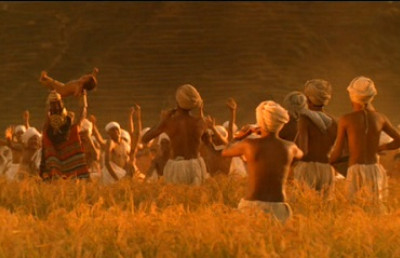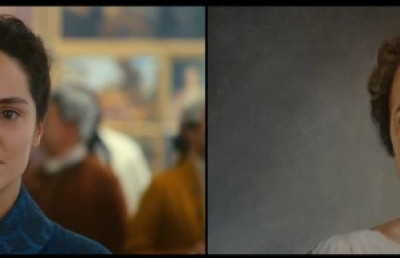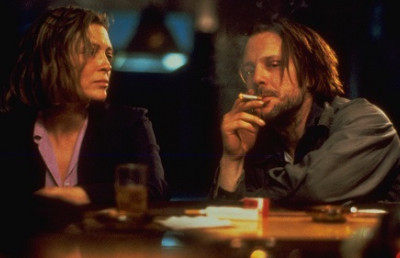Richard A. Gilmore’s Doing Philosophy at the Movies
The Searchers, Vertigo, Fargo, and Trainspotting
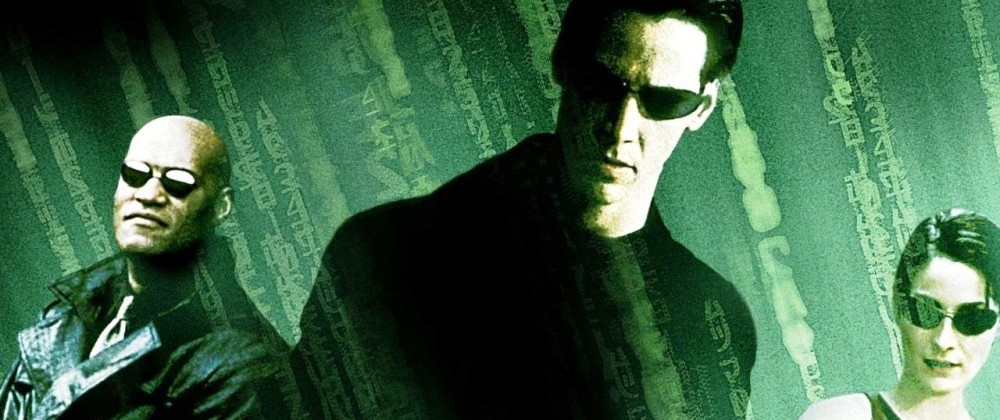
Doing Philosophy at the Movies
State University of New York Press
Albany, NY
183 pages (pbk); 2005; $21.95
ISBN 0-7914-6392-3
In Richard A. Gilmore’s Doing Philosophy at the Movies, Gilmore, a Concordia College philosophy professor, writes about The Searchers, The Usual Suspects, Vertigo, Fargo, Crimes and Misdemeanors, The Terminator, 12 Monkeys, Trainspotting, Night of the Living Dead, and The Matrix. He prefaces his film explications by noting the experience of watching a film when one begins to “register signs, clues, that there may be a larger narrative at work simultaneous to the explicit narrative of the primary plot of the movie. This might be called the meta-narrative of the movie. I will be considering meta-narratives in movies that derive from philosophical ideas from the great philosophers in the Western tradition” (viii). Such a task could seem—or be—dreadful, dull, pretentious, but it is not. Seeing Gilmore’s book in Manhattan’s St. Mark’s bookstore was a lucky accident. Richard Gilmore is a very good writer, and he is a man very much in touch with the human material of films—people, and what they say to and do with and to each other—and he is sensitive to (yes, he enjoys!) the resources of craft, feeling, imagination, insight, and wit filmmakers bring to their work. I have discovered over the years good film criticism in uncelebrated places—on websites devoted to psychiatry, socialism, and spirituality, or written by a lawyer, or placed in the pages of free newsweeklies—and I have read also the most celebrated and revered names, and even now I find Gilmore’s work very special. He is precise without being pedantic, serene without being boring, and wise without being arch or too earnest. He is clear and direct without losing the complexity of his thought. Richard Gilmore writes about film characters who hide the truth of their own desires, fears, and pains from themselves; and people who manipulate the affection or pride of others, who use signs and gestures to suggest a falsity is a truth; and people who misunderstand the relationship of values to given realities, overwhelmed by material pressures. Some of the film characters Gilmore writes about are people who see and appreciate just what is—practical and respectful; and others are people who will go to any extent to preserve a dishonest way of life, and get away with it. In his pages, and the films about which he writes, are people whose patterns of living suggest a struggle against anxiety and toward awareness and redemption; and also people whose habits are predominately physical, sometimes revealing how close are beauty and excrement. “Thinking is about trying to understand things. It is the attempt to move from a place of confusion and doubt to a place of understanding and of knowing what to do. This is the narrative of virtually every film that has ever been made,” Richard Gilmore writes in his book’s introduction (10). In Doing Philosophy at the Movies, Richard Gilmore discusses film with reference to various philosophers and writers, including Wittgenstein, Plato, John Dewey, Charles Sanders Pierce, Nietzsche, Slavoj Zizek, Herman Melville, Harold Bloom, Martin Heidegger, Richard Rorty, Homer, and Simone de Beauvoir. Richard Gilmore recognizes that art can illuminate morality and be itself morally ambiguous.
“The very fact that more meaning can always be discovered implies that at any given moment we live surrounded by a darkness of which we are only dimly aware, that our understanding is always only partial, that there is always more to know, that there is always a mystery that has not been solved. This is the abyss of the American sublime. It is the vaguely horrifying (vague because so dimly perceived) underside that haunts our American optimism,” writes Richard Gilmore near the end of his introduction (12) to Doing Philosophy at the Movies, which has thirteen sections, including a preface, pages of acknowledgments, a conclusion, notes, and index, with the primary portion being seven essays devoted to great popular films. “I believe that all seeing is interpretative, that there is no non-interpretive seeing. I also believe that there are better interpretations and worse ones,” he states (13).
Gilmore’s interpretation of John Ford’s The Searchers, a movie starring John Wayne, is interesting to me as Wayne is a man whose films I grew up seeing, someone admired by my parents’ generation, but someone whose work I did not give much thought to once I was an adult. I also do not think much of the genre, the western form, John Wayne worked in, with few exceptions (the westerns I like would probably be considered odd or revisionist: Little Big Man, McCabe and Mrs. Miller, Dead Man, Ride with the Devil); and yet I can hear, as I write, the enthusiasm we children felt, and voiced, for John Wayne. Gilmore reminds me of what a unique film The Searchers is: it is about something rarely admitted as significant in American culture—ethnic hatred. It is a re-imagining of the western form by a director and actor associated with some of the genre’s classics. An American man, Ethan Edwards, “caught in time, between an old order and the new order” (19) and played by John Wayne, is a man who has a family (his brother’s children, and their mother, his brother’s wife, with whom Ethan was infatuated with, as well as his brother) who are killed by indigenous Americans, the Comanche. Ethan embarks on a quest to find his abducted niece, Debbie, whom he thinks he will kill if she has become the bride of a native American; such is his prejudice against Indians. Gilmore describes Ethan as a failed searcher, someone with skill but imperfect knowledge—Ethan does not recognize that it is a trick when cows are led away from his brother’s farm so the men will follow, leaving the women vulnerable, and it takes Ethan fives years to track down the killer, his sworn enemy, a native named Scar, and that is accomplished with someone else’s help. Gilmore thinks that Ethan misunderstands the “true object of his search” (23), and that he is actually not in tune with his own nature, that he is more sensitive than he knows. Gilmore describes Ethan’s physical discomfort in his brother’s house, and suggests that the native American marauder Scar claimed Ethan’s brother’s wife’s body, and rapes her, as, possibly, Ethan wanted to: Ethan is a kind of misfit. “He cannot live within society because he cannot accept the diminishment of self that would require, he will not be placated, and so he cannot live among those who will be,” writes Gilmore (25), citing Ethan’s pain and anger. Ethan kills a buffalo herd as part of his vengeance against the Indians; and yet his delay in finding his enemy suggests Ethan may not want to find him or his niece. “It is my contention that the search for her took so long in part because he did not really want to find her. He did not want to find her because he did not know what to do if he did” (31-32). He did not know what was strongest in him, love or hate, forgiveness or vengeance. It turns out that the native, Scar, who killed Ethan’s brother’s family, the murder that began Ethan’s quest, was himself acting in revenge for the killing of his own family. Ethan’s journey is to learn something about himself, not only to find his niece. In the end, Ethan does not kill Scar, another man does, and Ethan takes his niece Debbie home with him.
As I think this summary of The Searchers makes plain, the film can be read as being about alienation from self and society, as about the relationship to the stranger (the other, the enemy), and as a quest for self-knowledge. It is as much about spirit and thought as it is about guns and seeing through another man’s dust. The film contains embodied ideas, and those ideas are apparent in Gilmore’s examination of the film. “What is deep in The Searchers is not just what it has to say about the human condition, but also the way in which the movie is structurally composed to elicit a very specific kind of understanding from us, an understanding that is nothing if not philosophical” (21). In the film’s violent central character, Ethan, Gilmore sees a reflection of Nietzsche’s finding that both “resentment and vengefulness are a response to pain” (25), so that Ethan’s inclination to brutal force is a sign that he has been too sensitive, too hurt. The film’s journey is toward Ethan’s recognition and acceptance of his pain, which is inevitable if one cares about others, and in being reconciled to himself, he will, to an extent, be reconciled with the world. Gilmore also notes how Ethan’s alienation puts him in a philosophical position: “The philosopher must stand outside society in order to understand the forces that impinge upon us as members of a society, of a community” (26). That philosophical position is what the characters in the films Gilmore discusses either have, come to, deny, or evade: in The Usual Suspects a detective’s mistake comes in denying the power, if not the existence, of other minds; in Vertigo, self-knowledge seems to be rejected, and fantasy preferred, which includes denying a woman her own reality; Fargo is about value and meaning in life, and one man’s failure to see them clearly; and Crimes and Misdemeanors about vision and blindness, truth and lie, right and wrong, and a man’s unusual choices; The Terminator and 12 Monkeys about identifying acts that could improve the future, and choosing those even if they require self-sacrifice; Trainspotting about finding beauty in what ordinarily seems ugliness; Night of the Living Dead about accepting death; and The Matrix about appearance and reality and recognizing one’s possibilities.
The Usual Suspects and Vertigo are films that involve calculated and inspired deceptions. “Both movies have central characters that are detectives who are confronted with puzzling, even mysterious narratives that they need to figure out,” writes Gilmore (33). Why might this be relevant? “We are all detectives trying to solve the mystery of the meaning of our lives,” he states (33). The Usual Suspects is about a group of criminals, and the search for a legendary mastermind, Keyser Soze. It is also about storytelling itself: what is a plausible tale? A detective interviews a lowly criminal and hears a story that satisfies the detective until he, stumbling on one clue and then another, realizes that it is a story, and a story made up of items—names, words, references—to be found on his own office bulletin board and environment. Gilmore asserts that it is not only the criminal who deceived the detective, but that the detective’s own confidence allowed him to be deceived. In Vertigo, a man, Scottie, is deceived, is presented with an image he thinks his real, of Madeleine, and he is compelled to make the woman he meets, Judy, relive that image, not knowing that she was part of the deception: and she is lost, as she comes to care for him. He cares more about the false image than the true image; and she seems to care more about him than about herself. This is not apparent early in the film, but when it is, when the film presents Judy’s perspective there is a “transformation of all of the previous narrative values” for the viewer (38), the kind of transformation that took place in The Usual Suspects, but this one involves—in the film—matters more personal than professional. Scottie asks Judy to dress as Madeline: “We no longer see her as the beloved Madeleine, but now as the vulnerable lover who will do anything for Scottie’s love in return” (40). Gilmore thinks of Scottie’s vertigo, his discomfort with heights and resulting dizziness, as a symptom of his discomfort with self and profession: it is a symptom that absolves him of certain kinds of actions. Scottie’s romantic obsession is disturbing, as is his heedless need for explanations. In Scottie’s commitment to reason, he seems crazed, a paradox. Gilmore, better than most, justifies the seriousness with which the film’s director, Alfred Hitchcock, is taken. (The screenplay is based on a novel, each written by others.) Gilmore concludes, “Both movies, both The Usual Suspects and Vertigo, end quite darkly. Both end with the suggestion that we will not figure things out in time” (55). He suggests the difficulty and importance of genuine and independent voice and vision.
Marge Gunderson, a mid-western American police officer, in the Coen brothers film Fargo has not only a unique voice, but it comes with an accent. It is cultural, regional (Minnesota); and as her comments are full of observations and a warm humor, it is personal too. Marge is someone who has a simple life—work, husband, and a baby on the way—and it turns out that this is just enough for her, and it offers her enough perspective to be able to handle the unspoken confusions and violent chaos in other people’s lives. Jerry Lundegaard, a car salesman, is a man whose desperate attempt to make money and achieve independence led him to propose a business deal to his intimidating father-in-law that the man then cuts Jerry out of; and Jerry decides to have his own wife kidnapped and ransomed to her father. It is a risky, sad, stupid plan—and Marge becomes involved in the crimes that take place: she represents and enforces the law, but she also represents something flexible, thoughtful, humane. “I see the character of Jerry Lundegaard as enacting the wrong way to grasp the American sublime and the character of Marge Gunderson as enacting the right way,” declares Richard Gilmore in Doing Philosophy at the Movies (61). Gilmore says that Fargo, North Dakota, where Jerry finds his kidnappers, represents a place that is “other” to Minnesotans: and the men Jerry finds there, Showalter and Grimsrud, are certainly that, especially Grimsrud, who seems comfortable with his own pathology (before the film is over he will feed Showalter to a wood chipper). Money and property have had a demeaning and deadly influence in the lives of most of the film’s characters. “What Jerry was lacking, and what Jerry really needed, was not more money or more property but more philosophy. That goes for his wife, his son, and his father-in-law as well. Every activity, to be done well, requires criticism, some process by which errors can be corrected and performance improved” (73), asserts Gilmore, who echoes John Dewey in calling philosophy a criticism of criticisms.
It might be said that the central character, Judah, in Woody Allen’s film Crimes and Misdemeanors is a man who refuses self-criticism, a man who insists on his right—or just his privilege—to be wrong. Judah has an affair and contemplates authorizing the murder of his mistress to cover it up. The film is about secrets and lies, suggestions and consequences, crime and no punishment. Gilmore recalls the ethical considerations of Socrates and Aristotle when discussing the film, just as Gilmore invoked Immanuel Kant’s ideas regarding the sublime, and John Dewey—for his pragmatism, for his commitment to clarifying meaning—in Gilmore’s account of Fargo, and Nietzsche’s thoughts on suffering and individuality when discussing The Searchers. How can we see or know the ethics of others? Privacy can protect our lives from violation—and also inspection. When someone makes a disclosure about his (or her) private life, how do we know we can trust it? “Metaphors of vision and perspective are pervasive in the film. Judah is an ophthalmologist; Lester is a television producer; Cliff is a film producer; Ben the rabbi is going blind and wears increasingly darker glasses; Judah needs glasses, but does not usually wear them; Cliff needs glasses and wears them, as does Louis Levy, the philosopher; Halley wears glasses at first, but not later. Judah attempts to avoid being seen, i.e., found out, by having Dolores, the woman with whom he is having an affair, murdered” (83). Judah will have a secret that hides a secret. Gilmore speculates—not with my approval—about how the film is both about Woody Allen’s created character (Judah) and his real-life character (his own moral consciousness), gesturing toward a private secret that became a public scandal in Woody Allen’s life. Gilmore sees our turning our lives into stories as meaning-making, and that the film “presents a lesson in the activities of narrativizing and interpreting themselves. Each person must produce his or her own interpretation of the events of the film, just as each must produce his or her own interpretation of his or her own life and the world in which we live” (92-93).
Some of the stories I like best—they’re fantastic, but I also find them meaningful—are science fiction stories, stories about what the future might become. I see these stories as experiments in thinking, in living. Science fiction stories, whether on paper or film, help us to imagine isolation and community, work and leisure, disaster and peace; and through them we can think about what we want, what we need, what we must do. The Terminator is a film I once did not take seriously at all, but I liked the trajectory of the series: in the first, a robot terminator arrives from the future to kill the mother of a future leader, and in the second, a re-programmed terminator arrives to protect that mother’s son (the third has a similar plot as the second, but I cannot recall if I saw it; probably not). I thought that the films could be given a political meaning—regarding the impulse to repress rebels. Richard Gilmore sees The Terminator and 12 Monkeys, a film about a return from the future to the past to track down the origins of a viral epidemic, as both embodying social anxieties and tensions and offering plots that make redemption—including the saving of the human race—possible. Gilmore cites Jean-Francois Lyotard’s commentary on the terror that capitalist control introduces into people’s lives, and notes how this corresponds with Heidegger’s notion that our replication of social control—a control wielded with pride—in our individual lives leads to false existences. The terminator, in the original film, represents an efficient, faultless consistency, the inhuman, and it is on the prowl to destroy the human. How does one fight that? With a form of self-creation, which involves imagining the future and the steps it takes to get there, to become who you need to be. How? With connections to others, which involves their sacrifice of doubt and abandoning of ordinary social consensus. “The Terminator and 12 Monkeys do not celebrate macho violence so much as they celebrate inventive strategies for creating meaning in one’s life. In both movies, all of the proponents of violence as a solution to what confronts them are portrayed pejoratively, especially the punks and the police in The Terminator and the various versions on the mad scientists and radicals in 12 Monkeys,” writes Gilmore (105). One, still, has to accept death too.
Death and excrement are the curses we sometimes call upon each other’s heads, a very odd thing as each is inescapable. We do not have to wish them into existence; we, merely, have to accept them. Accepting is not the same as choosing, though that is a distinction that is sometimes lost, possibly because choosing does involve accepting. The film Trainspotting begins with a recitation about choices, many of them bourgeois. In his explication of Trainspotting, which features a heroin-addicted, pleasure-drunk young Scot named Renton and his friends, Gilmore announces, “In the scene that I would like to focus on, Renton enters a bar, and finds the way to the toilet…He finds quick relief, but then remembers the essential suppositories, now extruded. To the viewers considerable alarm, he immediately hops off the stool in order to plunge his hands down into his own fecal mess to recover the lost suppositories…He slips into the toilet entirely, sneakers last; onscreen we see a kind of heroic dive and underwater swim through pristine, but not undangered waters (he swims past a spiked land mine)” (110). Constipation is a result of Renton’s drug use, and a symbol of unhealthy psychic retentions, and defecation one of purging, even catharsis. If life is a struggle between order and chaos, Renton’s been captured by chaos: drugs can help or hamper; and Renton’s use of them seem to hamper: except that he enjoys much of the mess. Will Renton continue wanton Dionysian pleasure or gravitate toward bright Apollonian meaning? The film, as much a comedy as a tragedy according to Gilmore, shows Renton beginning, possibly ambivalently, to choose order.
How to live? How to die? Death appeals and frightens. Is death rest? Is it rot? Is it nothing? Is it endless want of humanity? It is certainly—like human existence, knowledge, love, and ethics—one of the great themes of philosophy; and in film death can inspire tears, laughter, or horror. Gilmore sees the zombies in Night of the Living Dead as oddly familiar: in accord with literature and our ordinary lives. “There is an initial fascination, a fascination with death and with the dead, a fascination that in one way or another works to summon some manifestation of the dead. Once the dead begin to arrive, however, once the reality of death becomes evident, there is a turn. The fascination becomes horror,” explains Gilmore (124-125), connecting the film Night of the Living Dead with Dante’s Hell and Odysseus’s visit to the House of the Dead in Homer’s Odyssey. (Gilmore also brings in Adorno, Plato, Walter Benjamin, Nietzsche, Schopenhauer, and Freud.) One experiences no disjunction with this odd combination. Does the distinction between high and low culture exist anymore? Maybe not—and I don’t think that’s a bad thing provided we think critically about all culture. Gilmore compares Odysseus seeing his mother drink blood to similar scenes in horror films: the familiar mixed with the strange, and a hunger born within the dead out of the living’s neglect of them. (Is the hunger merely imagined, out of guilt?) Gilmore suggests that confronting death can exorcise fear of it. Gilmore offers an interesting speculation when he writes, “To fully confront the eruption of our horror at the reality of death actually works to de-horrify it. The guilt of our horror, like the guilt of our laughter, is a guilt of subjectivity, the guilt of being an independent and living subject” (127).
Richard Gilmore’s Doing Philosophy at the Movies affirms that we can find thought and meaning in human activity and creations if they have been invested in them—and if we are open to seeing. The way we see existence, knowledge, and the other aspects of our lives are all part of our vision: our interpretive repertoire, our language and values and experience: our reality. Philosophy and film can make our terms as clear as black lines on white paper, as sharp as light in darkness. “In The Matrix, by the Wachowski brothers, a realm not unlike Plato’s cave is portrayed,” says Gilmore (142), and, of course, in the film a young man, Neo, gives up one vision (neat, conventional) for another (wild, radical): he chooses to look for the story beneath the story. He chooses to wake from sleep, from dreams. He chooses to think. It is the beginning of great work.


